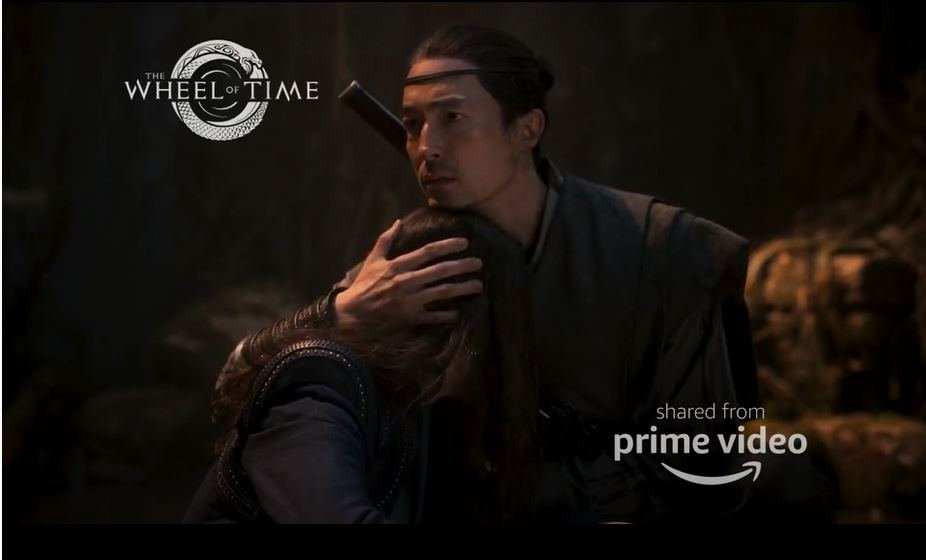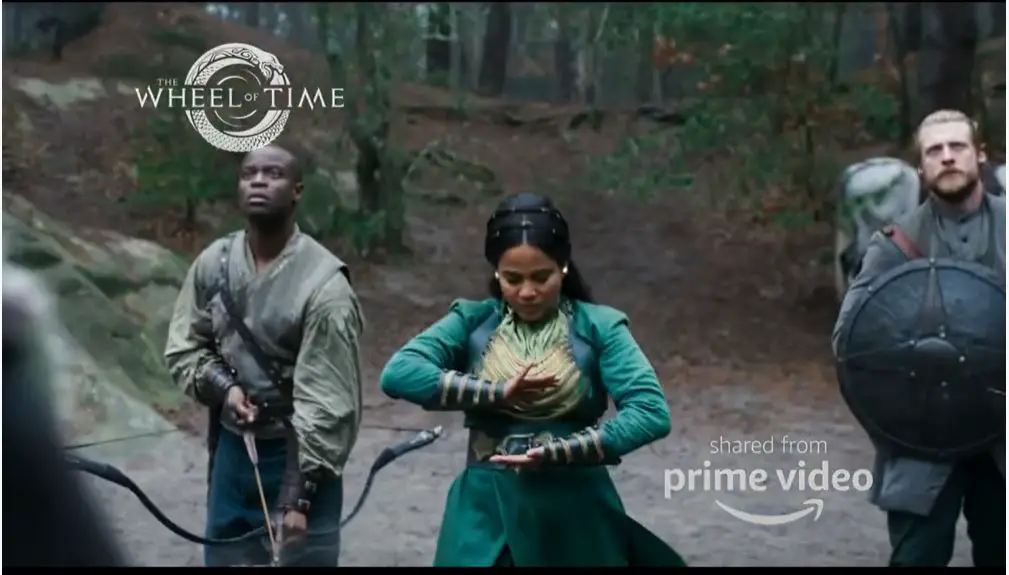This article contains show spoilers for The Wheel of Time on Amazon Prime.
The first season of The Wheel of Time on Amazon Prime Video is an engaging adaptation of the fifteen-book series. When I last wrote about The Wheel of Time, I mentioned the knowledge and dedication of the showrunner, Rafe Judkins. The effort and vision of Judkins along with many other talented individuals have brought Robert Jordan’s powerful, inspiring story to life. Judkins has captured an essential theme of the series: the infinite iterations of friendship and love.

The Wheel of Time series is a wonderfully sprawling story with 2782 named characters, and many “minor” characters have devoted fan followings. There are also significant events that occur across all areas of the Westlands, which means that not every character and scene can be included in the television series.
The Multiple Potentials of a Good Story
Some book readers have unhappily noted the differences between the books and show. I follow and participate in several fandoms, and I have been on all sides of book versus show debates. I do understand the angst of an unfulfilled head cannon, or worse, the elimination of details of textual canon that has a warm place in my heart.
As a literature professor, I am used to reading and discussing multiple perspectives in a classroom setting. It is normal and healthy for a group of readers to have multiple responses to a book or show. In fact, I love to learn about the different ways people read a fictional text. My only objection is when people become abusive in defense of their perspective.
A Repositioning of the Narrative
Regarding The Wheel of Time, the reason that the changes between book and show feel disorienting is that the books begin with Rand Al-Thor’s point of view, but the show repositions the opening of the story to bring Moiraine Damodred’s narrative to the forefront. The book series offers a traditional hero tale of a young man who must answer the call to leave his home and meet adventure when a wizard (Moiraine) arrives in his village. The show introduces us to Moiraine’s quest (and her personal sacrifices) to locate The Dragon Reborn so he can save the world.
I love The Wheel of Time, and Robert Jordan’s ability to draw appealing characters, especially Rand Al-Thor and Egwene Al ‘Vere, keeps me interested throughout the entire series. The show’s change in narrative perspective makes sense because in the books it is Moiraine and her best friend Siuane who have been on a years-long mission to find The Dragon Reborn. Moiraine and Siuan are Aes Sedai: Women who can channel the One Power.
Love

In regard to Siuan and Moiraine, one significant adjustment the show has made is to explore Moiraine and Siuan’s relationship. In Robert Jordan’s prequel to The Wheel of Time, New Spring, Moiraine and Siuan’s youthful relationship is described as “pillow friends” by Merean, a fellow Aes Sedai. Pillow friends is Jordan’s description for a female same-sex relationship in the Aes Sedai White Tower.
Merean shook her head with a smile. “Not troublesome, really. High-spirited. None of the tricks Moiraine played were mean, but they were plentiful. Novice and Accepted, she was sent to my study more often than any three other girls. Except for her pillow-friend Siuan. Of course, pillow-friends frequently get into tangles together, but with those two, one was never sent to me without the other.
Page 270 – New Spring
Jordan further elaborated on LGBT relationships in The Wheel of Time in a couple of blog posts in the early 2000s. He defined pillow friends:
“Pillow friends are not just good friends. Oh, they are that, too, but they also get hot and sweaty together and muss up the sheets something fierce. By the way, pillow friends is a term used in the White Tower. The same relationship between men or women elsewhere would be called something else, depending on the country.”
https://wot.fandom.com/wiki/Pillow_friends
In addition, he explained the presence of LGBT relationships in the Westlands.
For the most part, in this world such things are taken as a matter of course.
https://wot.fandom.com/wiki/Pillow_friends
In the books, Moiraine and Siuan continue to be portrayed as good friends who trust each other with their lives, but they are friends who have outgrown their teenage love affair. It is to the show’s credit that viewers get a better understanding of the depth of feeling these two characters have for each other due to the show’s onscreen exploration of their relationship.
Friendships, Oaths, and Bonds of Loyalty
There are other romantic relationships in The Wheel of Time. Some of the main characters (Rand Egwene, Perrin, and Mat) have been aged up which allows for romantic liaisons (and troubles) to be realistically portrayed. However, the show also depicts strong feelings between friends, and it explains the bonds between Aes Sedai and their Warders.
The oath-created bonds between Aes Sedai and Warders are especially interesting because they run the gamut from deeply loyal but strictly platonic, as in the bond between Moiraine and Lan Mandragoran, to romantic and even polyamorous such as between Alanna Sedai and her warders Maksim and Ihvon. The many characters and their loves and friendships provide readers with much to think about in terms of the levels of love, friendship, and loyalty in the human experience.

World Out Of Balance
I’ve often read comments from cis male fans that Robert Jordan’s books helped them cope at a critical time in their lives. This makes sense because another significant theme of the series is that of healing one’s mental health. Given this, it is understandable the show’s change of perspective is disorienting for those readers. I, too, felt disorientation. However, one often accompanying complaint is that the first season is giving female characters prominence over the male characters. Some book readers state that their favorite character, Rand, is given little screen time to demonstrate his strength.
One of my favorite non-reader reaction video channels on Youtube, Everyday Negroes, gave Rand the nickname Brother Sensitive. I love this observation because it is true. In the first season, Rand is portrayed as quiet, loyal, loving, humble, yet distrusting of Aes Sedai, especially Moiraine. What disgruntled fans may not have realized is that Rand’s essential strengths are being portrayed. Don’t we all hope for a Dragon Reborn who has humility?
In addition, the minimization of male characters in the opening episodes is a depiction of society’s values in the Westlands, or Randland as some book fans call it. Similar to how women in our real world often are underestimated, men in the Westlands experience the same fate. It is a world out of balance. In the Westlands, female Aes Sedai can safely channel the One Power while men who can channel eventually go mad due to the Dark one’s taint on the male half of the One Power.
The show depicts this imbalance beautifully. It is clear that Rafe Judkins is thinking ahead, and he even assured fans of this in a recent Instagram question and answer session.
Non-readers who are show watchers are catching on to the reasons for each character’s specific attributes. Adison, Andre, and Brandon of Everyday Negroes comment on the full meaning of Rand’s characterization at the end of Episode 8 when he rejects the temptation of the Dark One by rejecting the possibility of sharing a life with the woman he loves. He knows she would not choose that path for herself. As non-book readers, they perceptively realize that Rand’s supposed weakness, his sensitivity, is also a great strength. In fact, his mistrust of female Aes Sedai makes perfect sense if he is sensing the trauma experienced by his soul in his previous incarnation as Lews Therin Telamon.
One Power: Healing the Fandom
The Wheel of Time fandom, book and show fans alike, have an opportunity to reach for the balance that Robert Jordan’s characters seek, but balance is best achieved in partnership with others. We can’t know what Robert Jordan would have wanted in the show, but we do know he wanted readers to appreciate his story. As a writer, he would also know that different readers take away different meanings from a story. The one who knew him best, his editor and widow Harriet McDougal, and writer Brandon Sanderson, who finished the series after Robert Jordan’s death, are both consulting producers on the show. Sometimes, whether in regard to an adaptation or in regard to each other, we are more at peace when we assume good will.
Fans love to refer to canon, and I am as guilty as anyone of wanting my favorite books to be adapted according to my specific emotional needs, yet I also believe in Madeline L’Engle’s assertion that a book can stir up fresh life endlessly. In fact, a good book always will.
If we take anything from Robert Jordan’s series (book or show), let it be that we must express love and respect to each other, and that we must seek a balance between the dark and the light.
Images courtesy of their respective owners.
Have strong thoughts about this piece you need to share? Or maybe there’s something else on your mind you’re wanting to talk about with fellow Fandomentals? Head on over to our Community server to join in the conversation!

